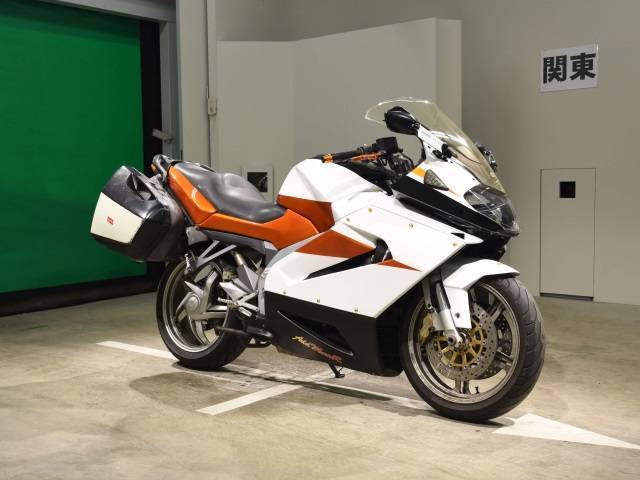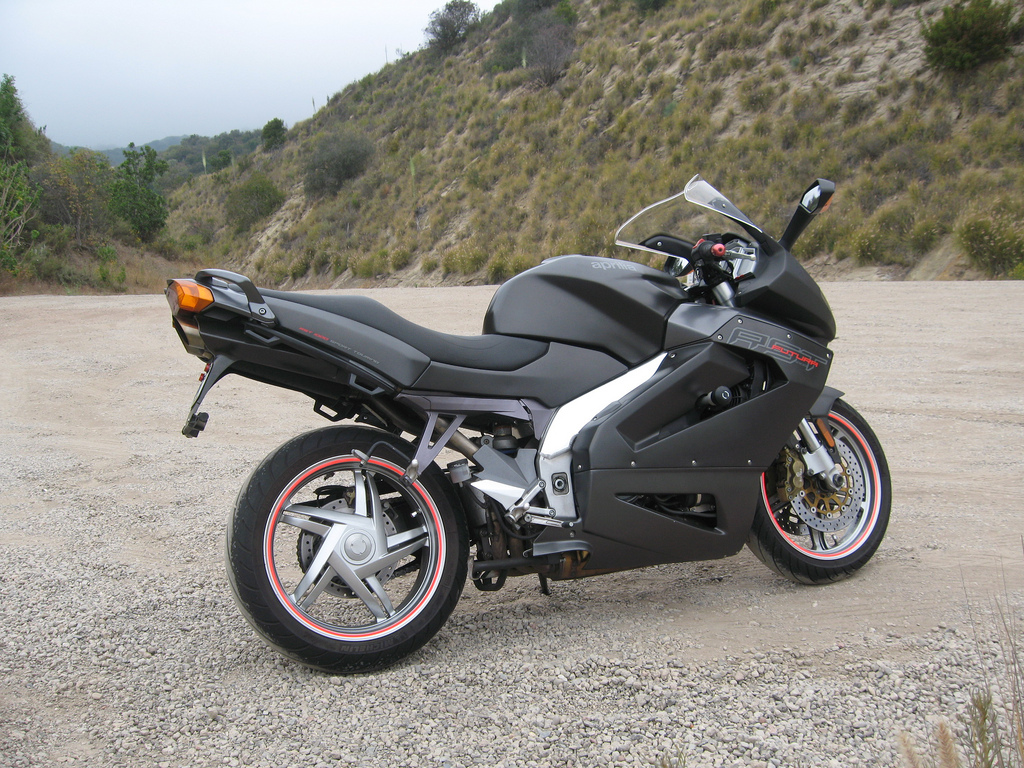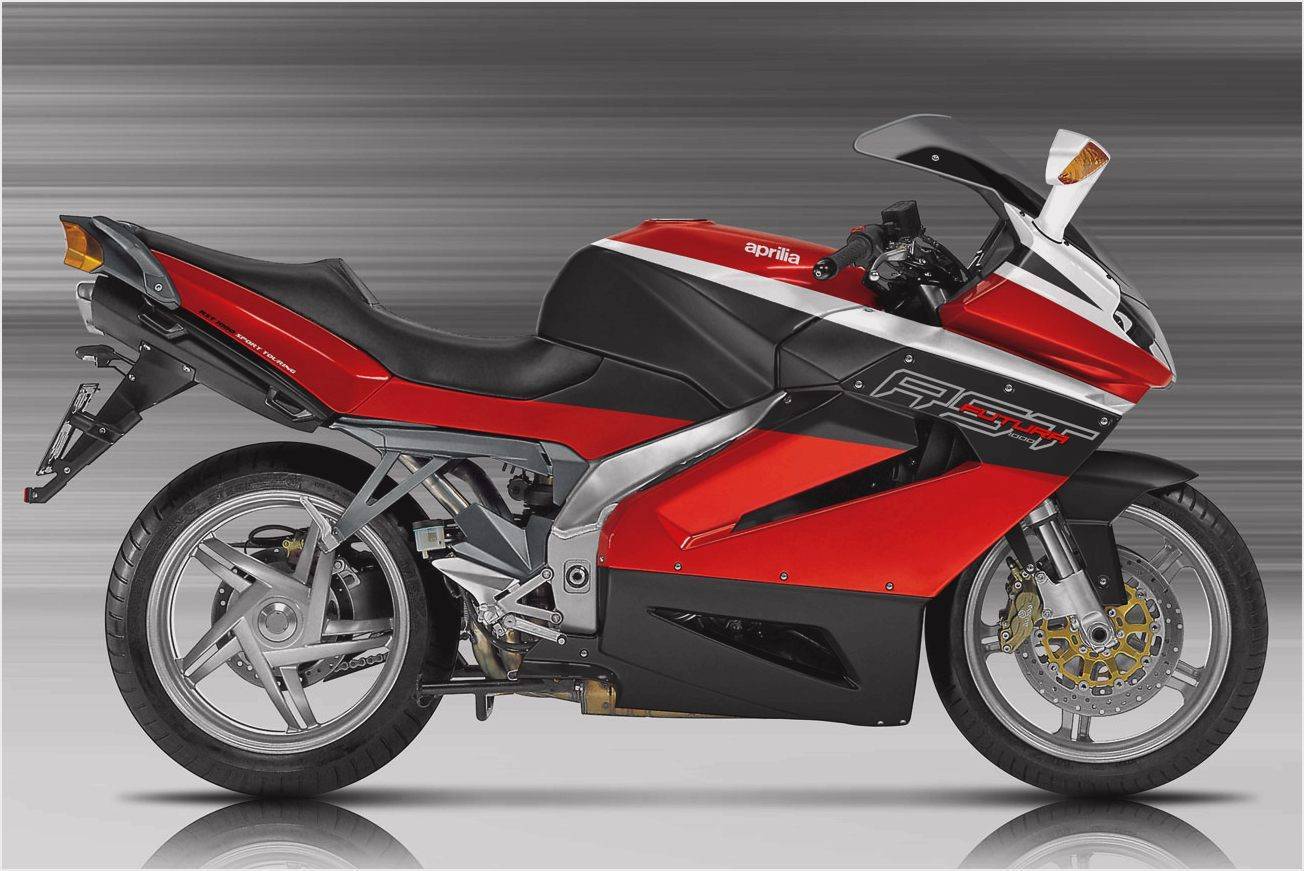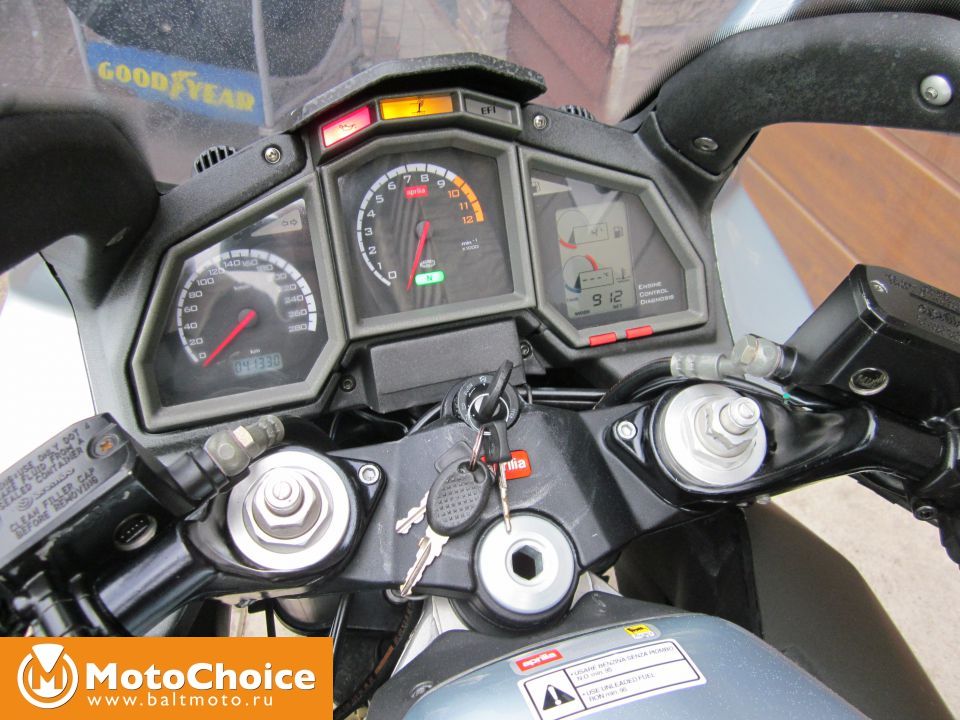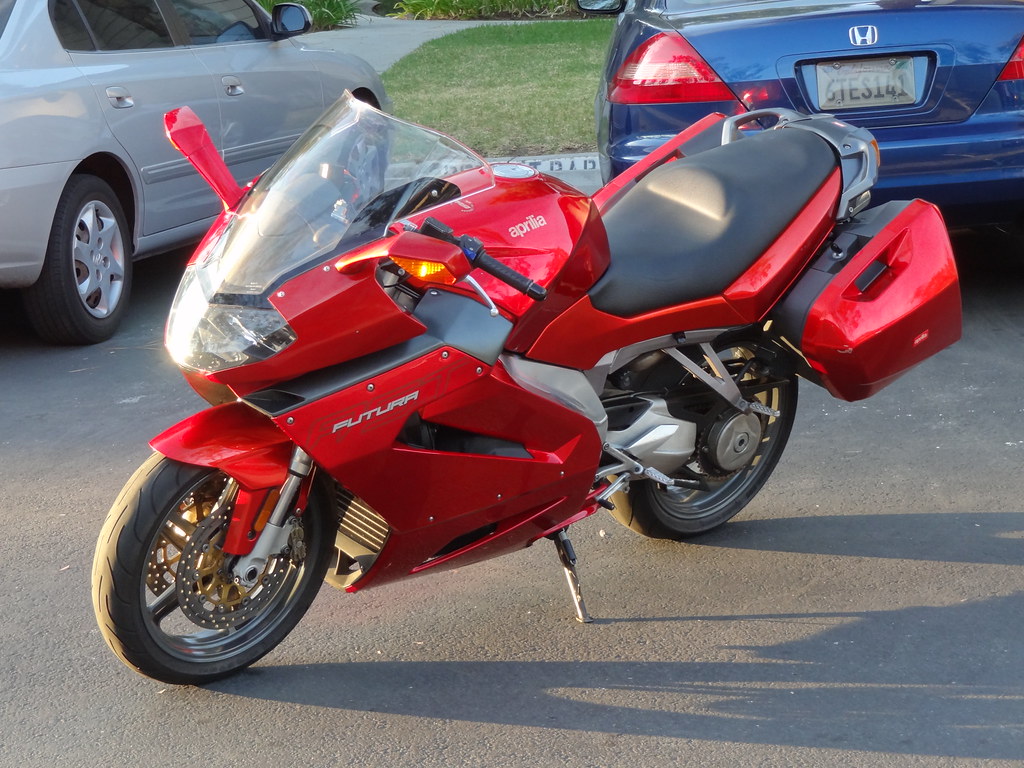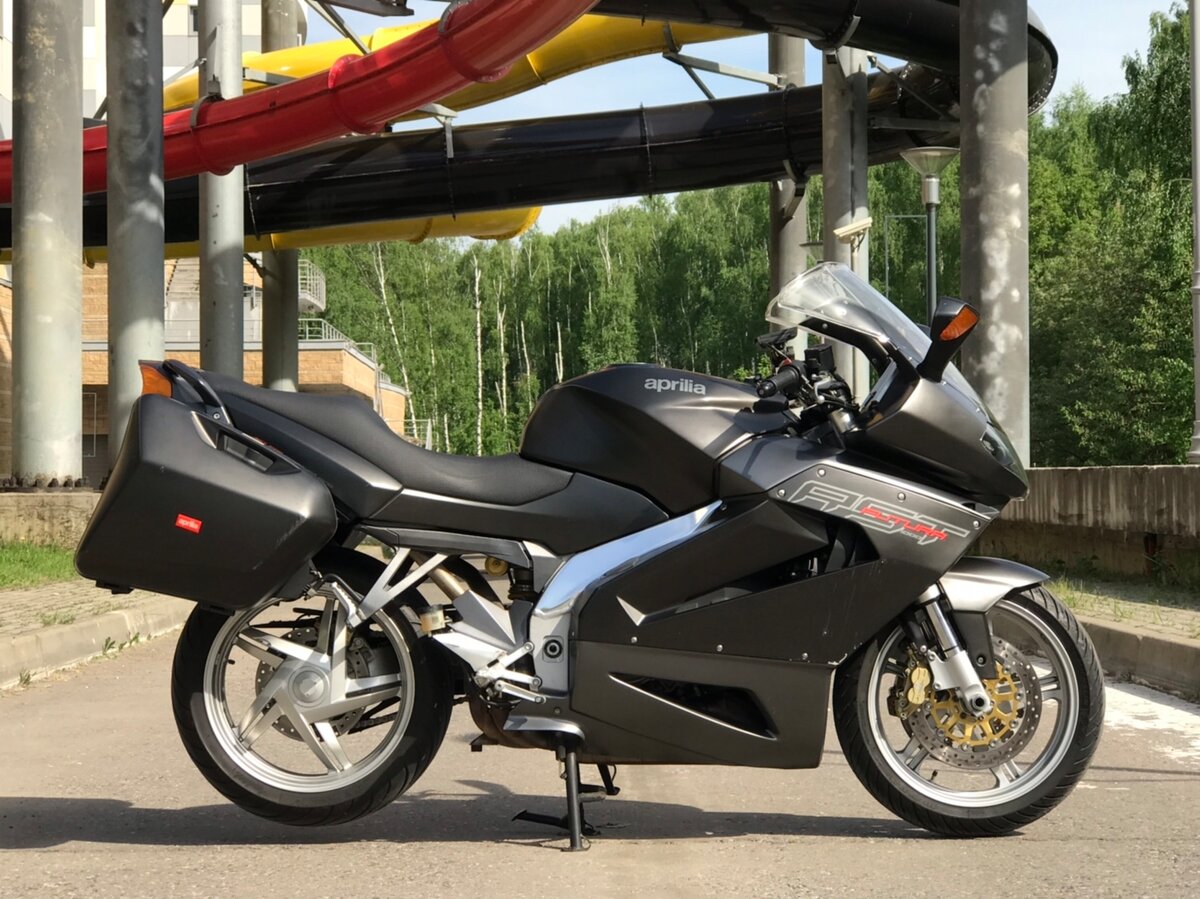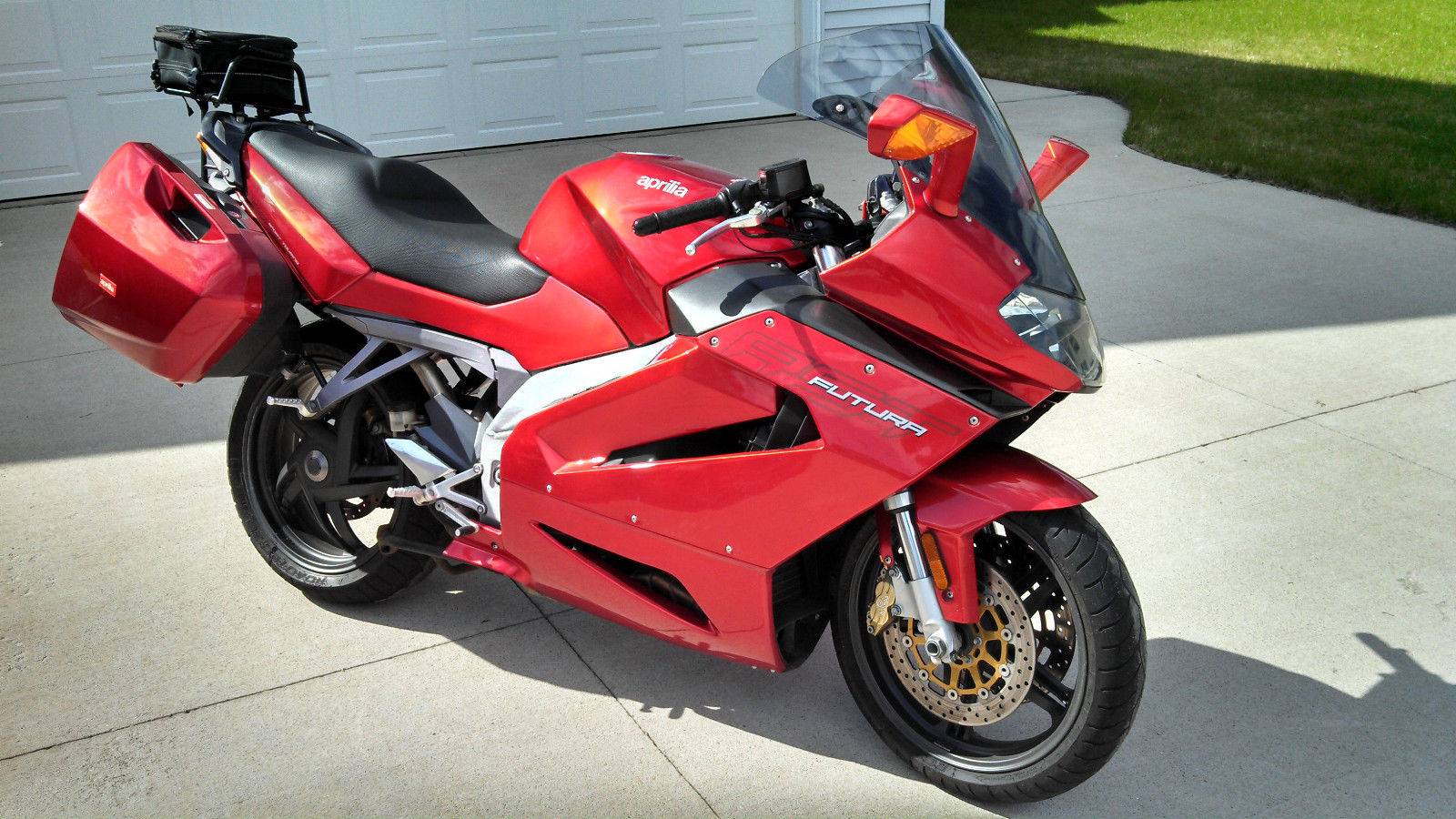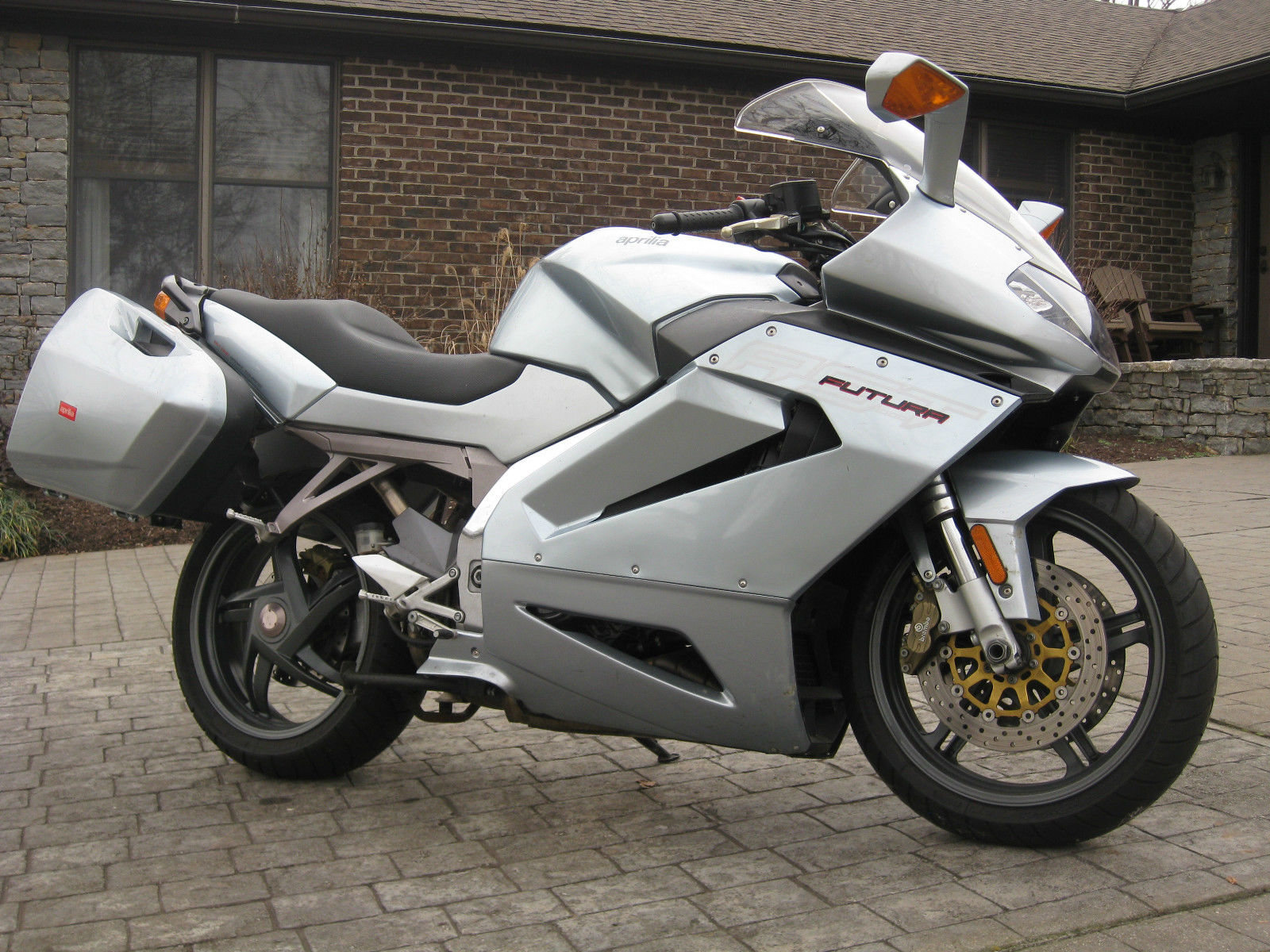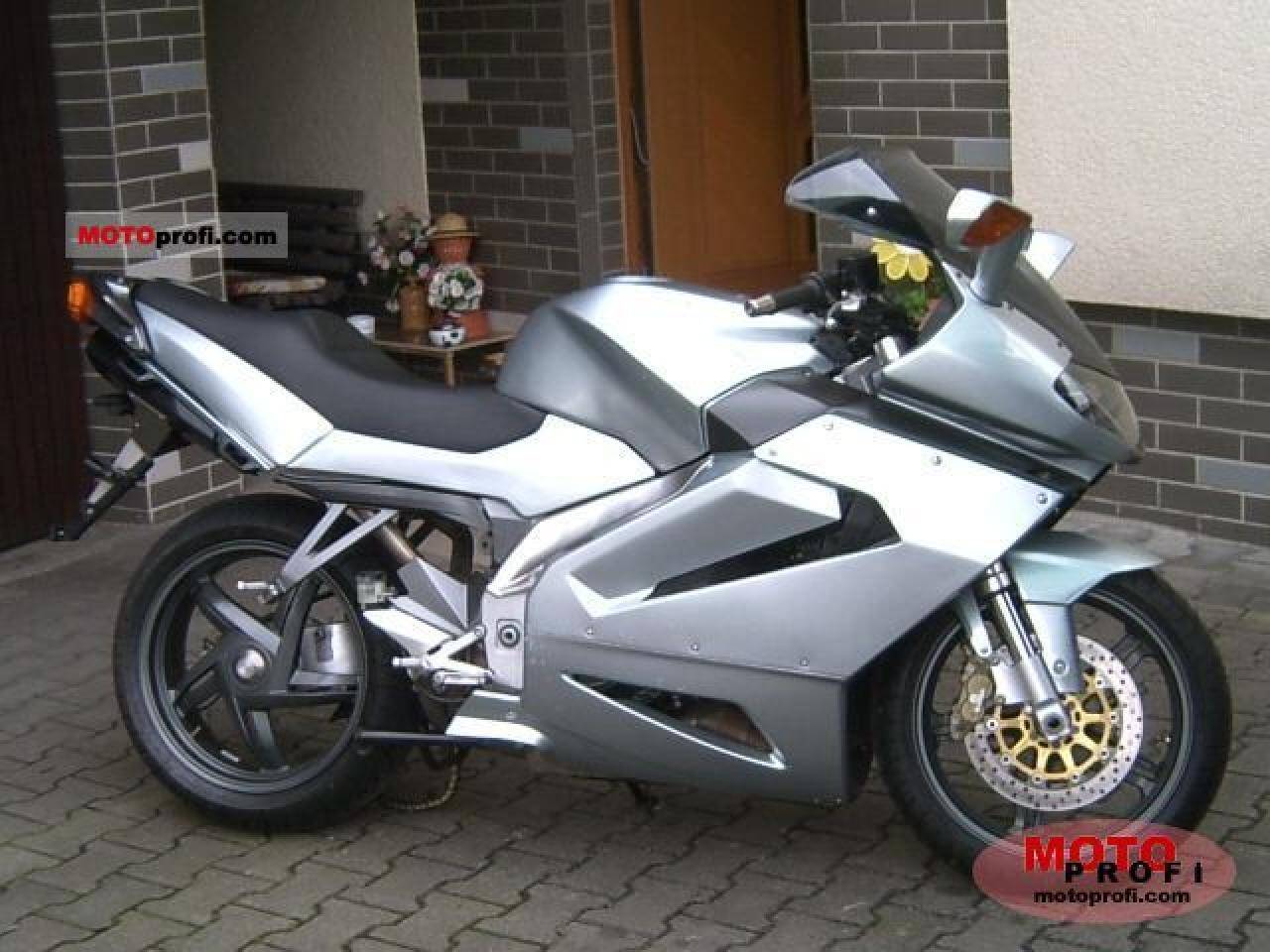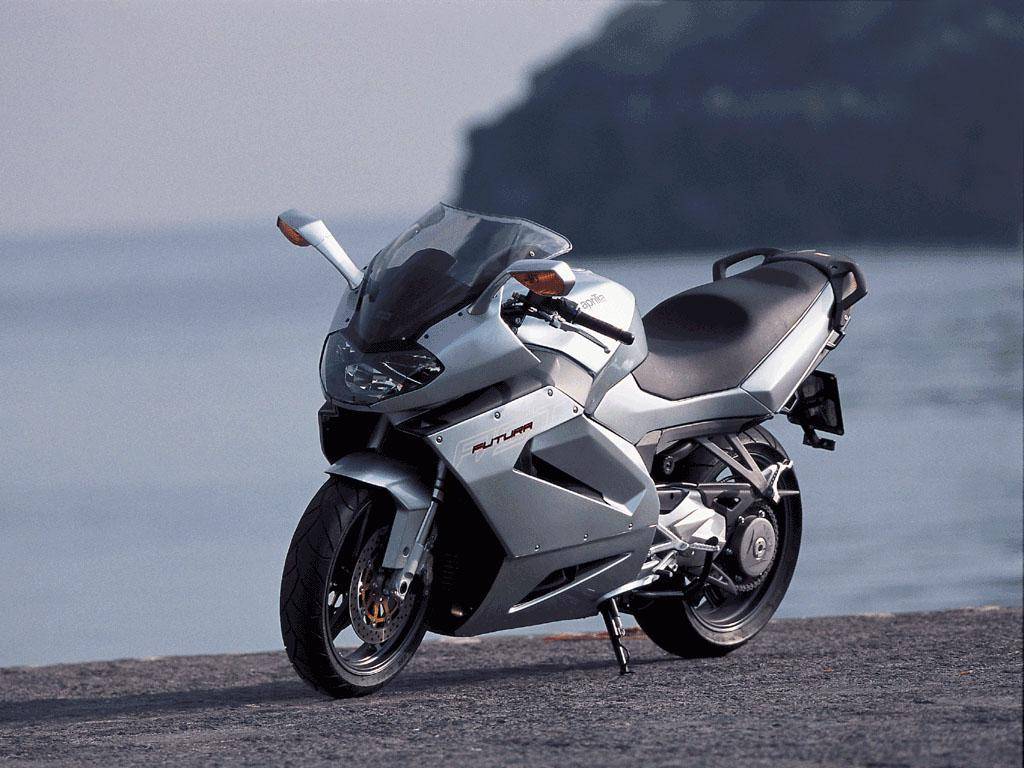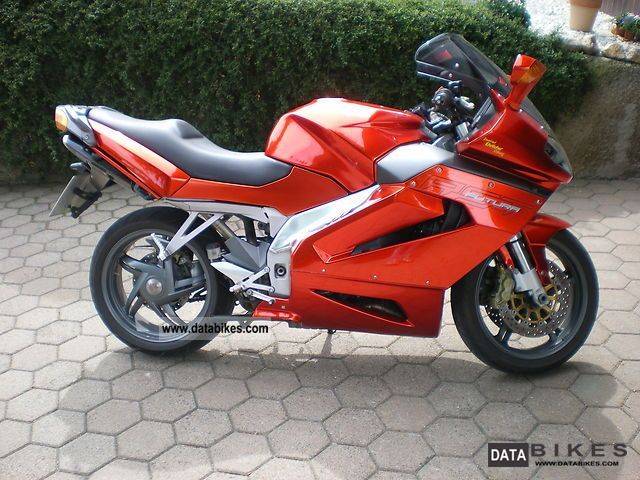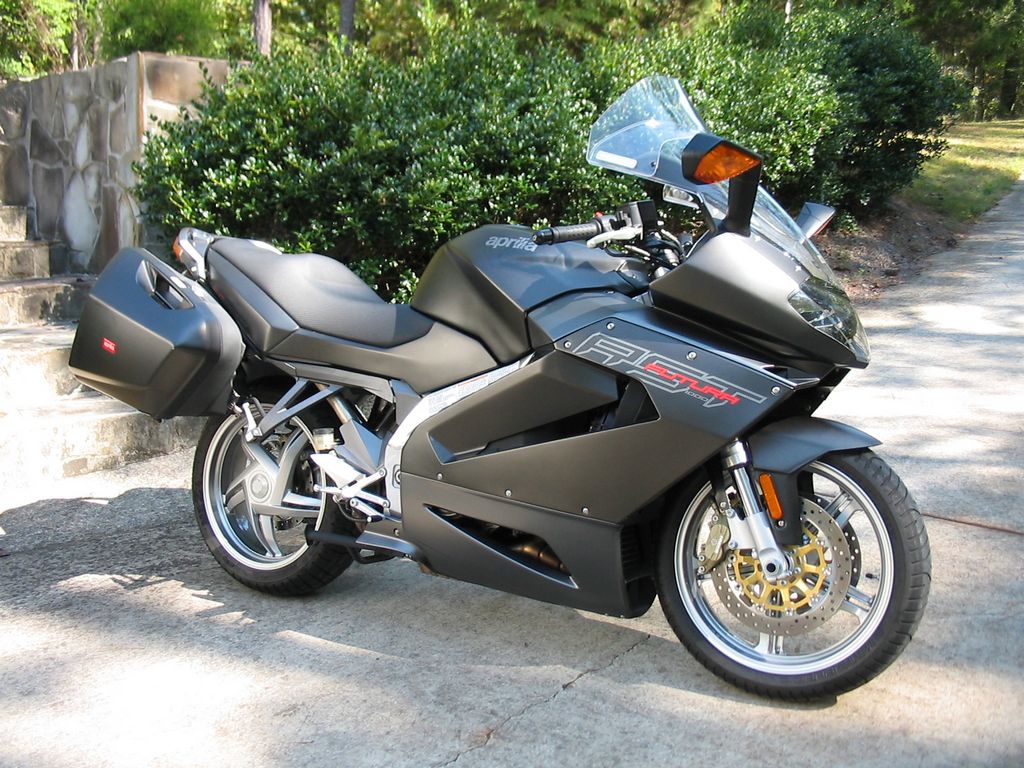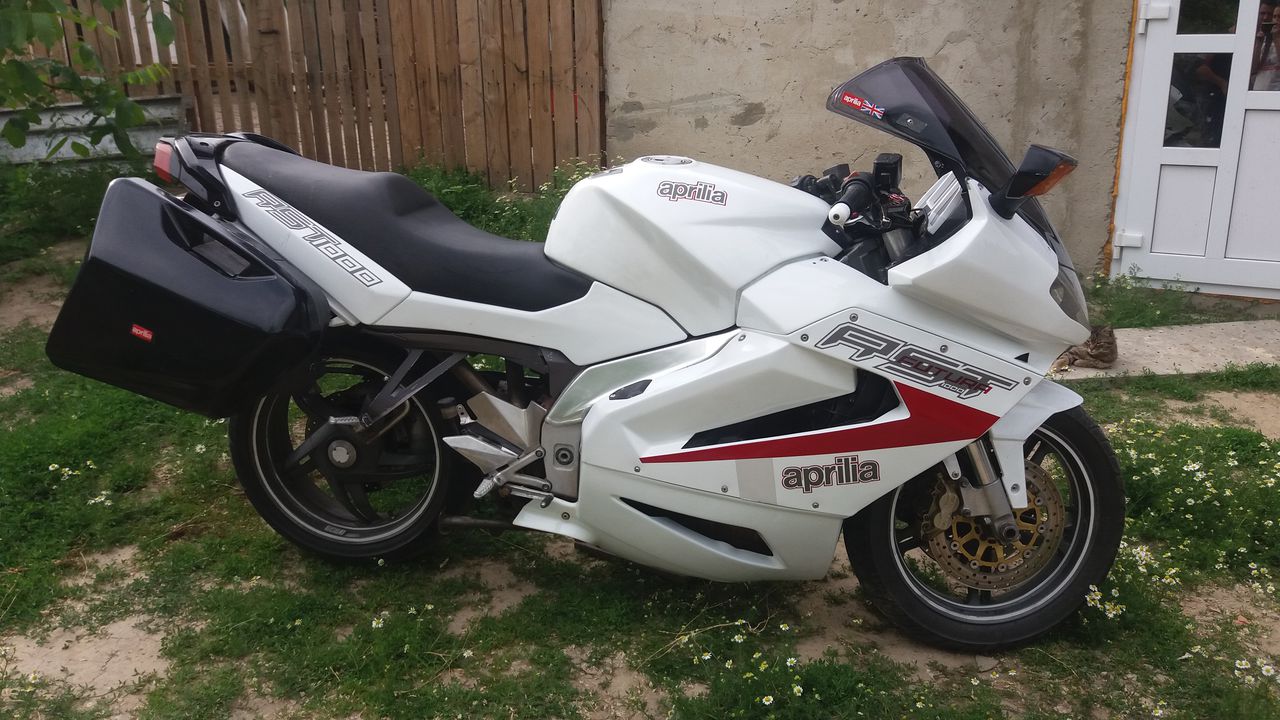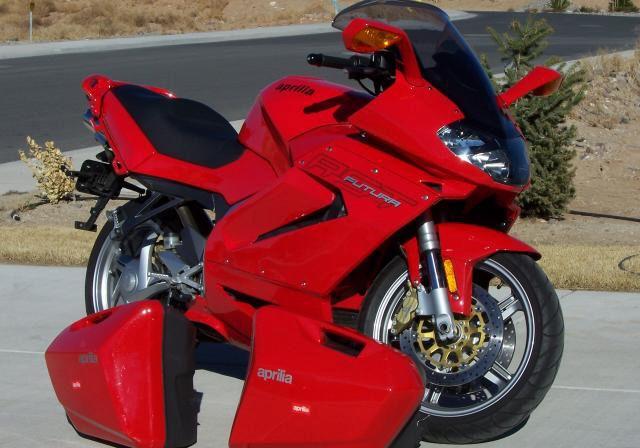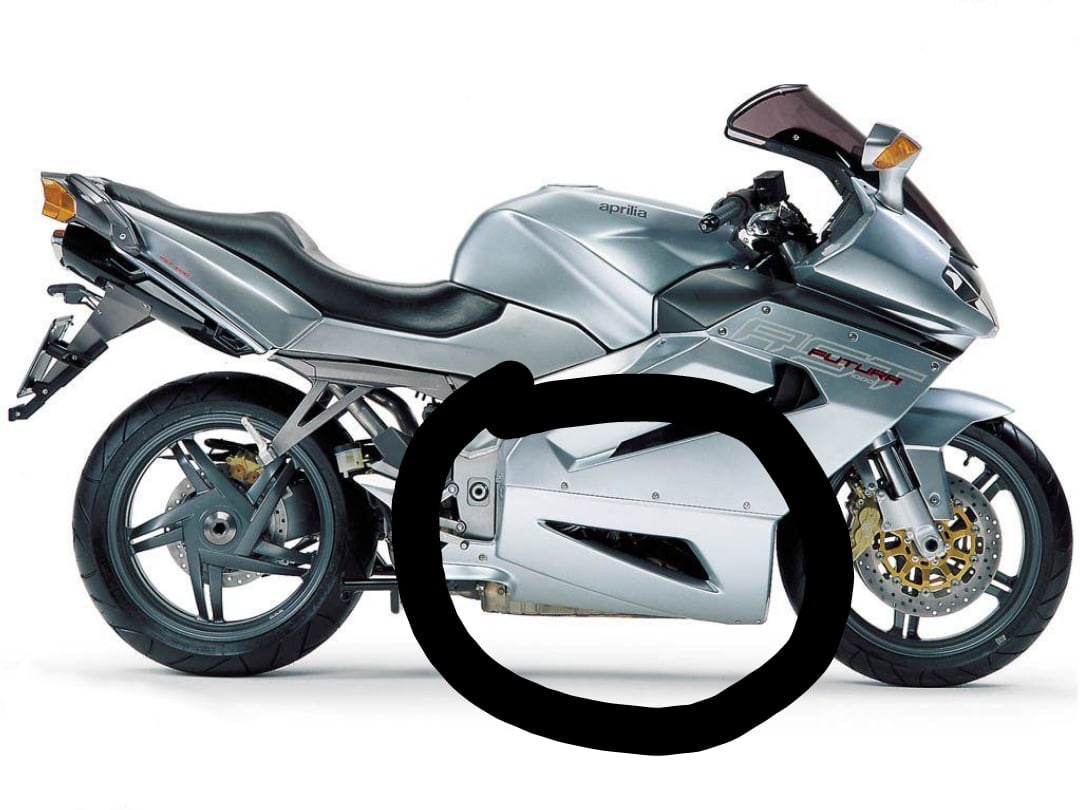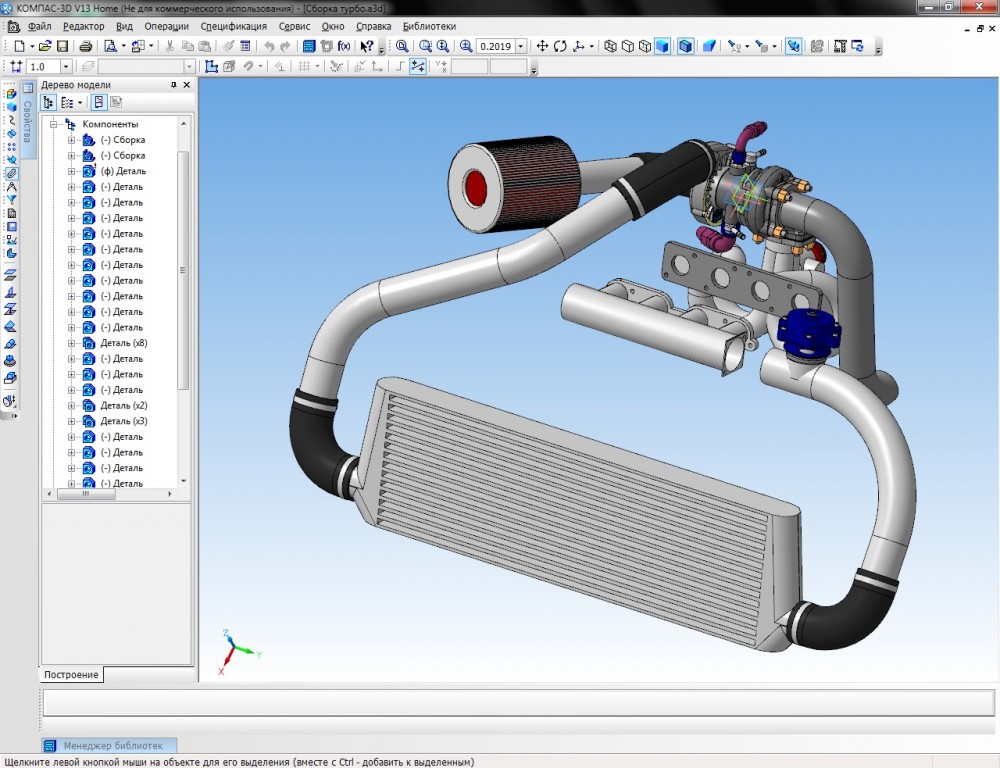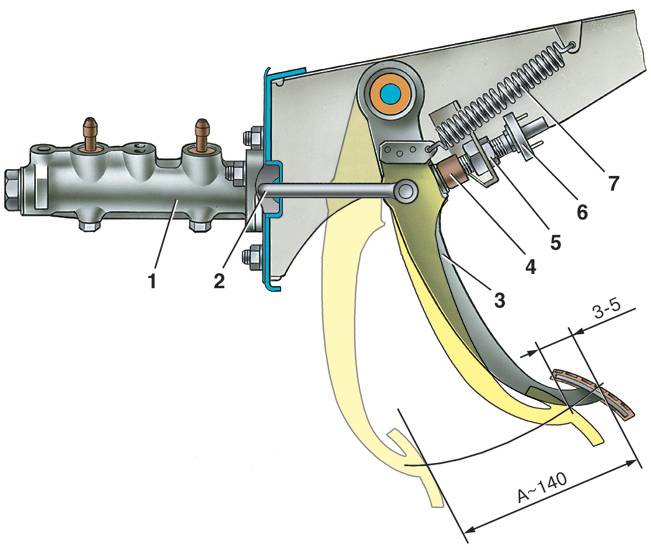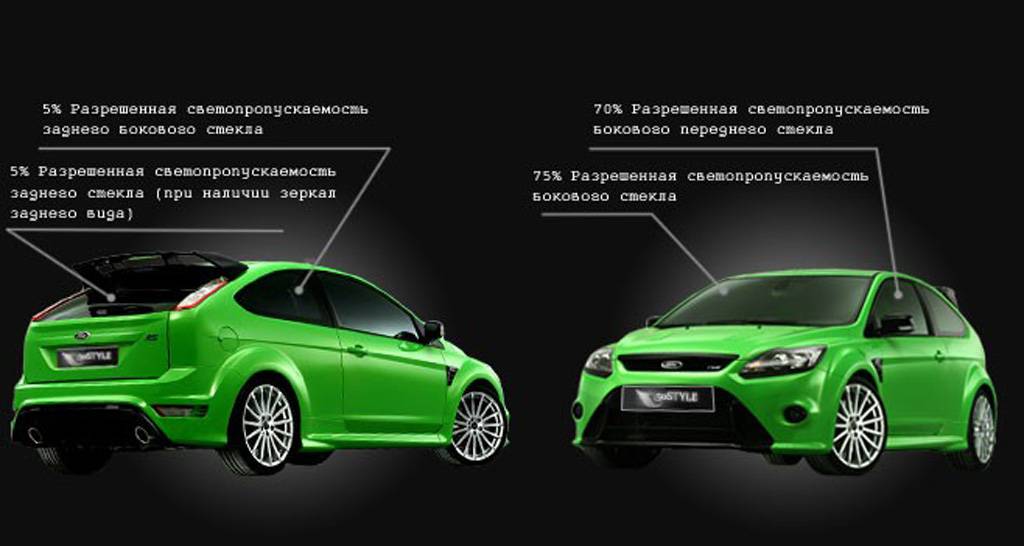Specifications[edit | edit source]
| Make Model | Aprilia RST 1000 Futura |
| Year | 2001 |
| Engine | Liquid cooled, four stroke, longitudinal 60°V twin, DOHC, 4 valves per cylinder |
| Capacity | 997.6 |
| Bore x Stroke | 97 x 67.5mm |
| Compression Ratio | 11.8:1 |
| Induction | Fuel injection |
| Ignition / Starting | Digital electronic with two spark plugs per cylinder / electric |
| Max Power | 113 hp 83 KW @ 9250 rpm (rear tire 101.8 hp @ 9250rpm) |
| Max Torque | 7.78 kg-m 96 Nm @ 7250 rpm |
| Transmission / Drive | 6 Speed / chain |
| Front Suspension | Showa upside-down 43mm fork, adjustable in brake, rebound and preload. 120mm wheel travel |
| Rear Suspension | Swing arm in Aluminum alloy, progressive linkage. Sachs hydraulic shock absorber, adjustable in brake, rebound and preload |
| Front Brakes | 2x 320mm discs 2 piston calipers |
| Rear Brakes | Single 255mm disc 2 piston caliper |
| Front Tyre | 120/70 ZR17 |
| Rear Tyre | 180/55 ZR17 |
| Dry-Weight | 210 kg |
| Fuel Capacity (res) | 21 Liters (5L) |
| Consumption average | 18 km/lit |
| Standing ¼ Mile | 11.6 sec / 123 mp/h |
| Top Speed | 239 km/h |
| Reviews | Motorcyclist / Motorsport it / Comparator Sport Tourer / Motociclismo / Motocorse / Motorcycle.com 1 – Motorcycle.com 2 – Motorcycle.com 3 |
DASH IT ALL[edit | edit source]
The dash is well laid out, utilising an easy-to-read clock-style speedo in place of the RSV and RS250’s LCD displays, and glows a funky blue in low light. There are also comprehensive idiot lights, as well as LCD engine temperature and fuel gauges, and a single trip meter, all accurate and handy for the long haul.
A keyhole on the left of the dash intrigued me though – what the hell was it for? Turning it didn’t seem to do anything at first. It turned out to be the seat release, which allows the entire seat unit to be lifted, rear side panels and all!
There isn’t room underneath for anything much larger than the adequate Aprilia tool kit. That’s what the optional panniers ($1,209) are for I guess.
The panniers are a decent size too, the under-seat exhaust meaning the panniers are of equal size due to not needing to make room for a muffler.
I reckon the muffler looks good from behind, and in fact liked the styling in general, although the looks received a mixed reaction from various people.
Talk centred around the angular fairing, and the fact it could date quickly – only time will tell…
The mirrors, too, are part of the whole styling exercise, incorporating the indicators in the mirror body. The left mirror on the test bike vibrated excessively, making the view a blur, while the right mirror performed adequately, though a little small.
2005 Aprilia RST 1000 Futura[edit | edit source]
The 2005 MY Aprilia RST 1000 Futura sports a liquid-cooled, four-stroke, 998cc, V-Twin powerhouse mated to a six-speed manual transmission and can produce a claimed 113 horsepower and 96 Nm of torque. This sportbike addresses those riders who want to spend more time behind the bars, thanks to features such as improved ergonomics, a more comfortable riding position, side panniers, and a full-fairing with a small windscreen.
2001 Aprilia RST1000 Futura in red
The Aprilia RST1000 Futura was a V2, sport touring motorcycle that was produced by Aprilia from 2001 to 2005. It is equipped with a 113 horsepower (85 kW) four-stroke 60° V-twin engine with electric-start, liquid cooling and electronic fuel-injection. The engine is broadly similar to that fitted to the Aprilia SL1000 Falco. It could reach a top speed of 149 mph (240 km/h). Max torque was 70.81 ft/lbs (96.0 Nm) @ 5500 RPM. Claimed horsepower was 111.57 HP (83.2 KW) @ 9250 RPM.
With its hard-shelled panniers, the Futura was intended to compete with the similarly styled Honda VFR800, but poor sales and Aprilia’s worsening financial position led to the Futura’s demise. Production ended in 2003, although the bike remained in the range until 2005.
PADDED PERCHES[edit | edit source]
I gave the seat little thought, a sure sign it’s comfortable, my pillion later confirming that the rear accommodation is equally as comfortable.
In fact the seat was still comfortable right up until my first fuel stop 245km later, the bike returning a handy 15.6km/lt. The tallish gearing no doubt helps here, with 100km/h equating to just 4000rpm in sixth (top).
This equates to a touring range of around 280km in highway mode before the fuel light blinks on, signalling five Liters left in the 21-litre tank. The pie-style LCD fuel gauge proved accurate, also.
Helping the rider squeeze in the last drop of premium unleaded is the off-set fuel filler, designed to sit at the highest point on the tank when the bike is on the sidestand – no more arguing with service station attendants over dismounting to fill up…
Whilst I will never mark riding the Hume as one of my favourite stretches of tarmac, the Futura went a long way towards making it bearable – partly because it was so comfortable, partly because I could get it over and bloody done with in short order thanks to the impressive fuel range and comfort!
As comfy as it is on the highway, turning on to the Snowy Mountains Highway was a relief, despite the plummeting temperature (down to nine degrees by now).
With the impressive high beam lighting the deserted highway ahead, I could really get down to enjoying myself, the stability through long sweepers feeling secure enough, whilst line changes mid-corner (dodging potholes and gravel patches) only required a light touch on the bars.
DASH IT ALL[edit | edit source]
The dash is well laid out, utilising an easy-to-read clock-style speedo in place of the RSV and RS250’s LCD displays, and glows a funky blue in low light. There are also comprehensive idiot lights, as well as LCD engine temperature and fuel gauges, and a single trip meter, all accurate and handy for the long haul.
A keyhole on the left of the dash intrigued me though – what the hell was it for? Turning it didn’t seem to do anything at first. It turned out to be the seat release, which allows the entire seat unit to be lifted, rear side panels and all!
There isn’t room underneath for anything much larger than the adequate Aprilia tool kit. That’s what the optional panniers ($1,209) are for I guess.
The panniers are a decent size too, the under-seat exhaust meaning the panniers are of equal size due to not needing to make room for a muffler.
I reckon the muffler looks good from behind, and in fact liked the styling in general, although the looks received a mixed reaction from various people.
Talk centred around the angular fairing, and the fact it could date quickly – only time will tell…
The mirrors, too, are part of the whole styling exercise, incorporating the indicators in the mirror body. The left mirror on the test bike vibrated excessively, making the view a blur, while the right mirror performed adequately, though a little small.
Дизайн [ править ]
Futura имеет раму из алюминиевого сплава с двумя параллельными балками и односторонним поворотным рычагом . Трансмиссия осуществляется через шестиступенчатую коробку передач и цепную главную передачу. Другие особенности включали систему двойного зажигания CDI , использующую две свечи зажигания на цилиндр, смазку с сухим картером , смешанную синхронизацию передачи и цепи, (AVDC) двойной балансирный промежуточный вал и муфту с гидроусилителем и гидравлическим управлением с запатентованной Pneumatic Power Clutch »(PPC ) для имитации проскальзывающего сцепления для управления подскакиванием заднего колеса при резком замедлении. Сухой вес Futura составляет 210 кг (463 фунта).
Главным дизайнером, отвечающим за проект, был . Он спроектировал Futura на основе того же двигателя, который использовался в Mille – 998-кубового DOHC с 60-градусным V-образным двигателем. Среди основных изменений по сравнению с Mille были односторонний поворотный рычаг и выхлопная труба, которые использовались для сохранения места для жесткого багажа. Маркони также указал на увеличение электрического генератора, чтобы справиться с аксессуарами, которые обязательно должны были добавить туристические гонщики. Электрическая мощность была увеличена на 30% по сравнению с Mille. Маркони поручил своей команде дизайнеров уделять много времени выхлопной системе. В результате сиденье не нагревается, как другие выхлопные трубы. Он также прошел стандарт выбросов Евро 1 без каталитического нейтрализатора. Команда разработчиков перешла к поставщику Sagem для обеспечения систем впрыска и впуска топлива.
Позже Маркони ушел, чтобы работать с Benelli, а затем с Gas-Gas. Именно его уход из Aprilia привел к тому, что обещанные обновления, такие как ABS и розетки, никогда не материализовались на Futura.
Overview[edit | edit source]
Ace Futura Story Sam MacLachlan A sportster with a comfy seat, or a tourer with sticky tires? Aprilia’s Futura blends fast with practical for a mile-eater with attitude.
It’s not often you see a bike with panniers sporting a set of sticky Michelin Pilot Sports. Or mixing a single-sided swingarm with quality pillion accommodation. The Futura does, and the result? A bike that can transport the rider large distances in comfort, yet still get up and boogie when the situation allows (demands?) it.
These features were perfectly suited to a recent mission of mine, which involved riding to Tumut (NSW) from my Melbourne home base to meet up with my Sydney-domiciled girlfriend, Bec – the hastily-arranged solution to an air travel (or lack of) problem!
Starting out from Melbourne around 5.00pm on a Friday meant battling traffic to the city outskirts, then a leisurely drone up the Fume Freeway and Snowy Mountains Highway in order to make Tumut at something resembling a decent hour.
STANDARD STOPPERS[edit | edit source]
The brakes were disappointing though, especially compared to the same marque’s RSV Mille which employs Brembo Goldline calipers.
The Futura’s brake rotors are downsized from the Mille (300mm from 320mm), which goes part way to explaining the difference in performance, though I reckon it’s probably more than that – pad material for instance.
While the brakes did the job, they are being stretched by the time a pillion and luggage are aboard, requiring a firm squeeze of the adjustable lever before they start offering much power, while feel at the lever was relatively lacking.
Wet weather also affected the feel at the lever more than usual. Swapping to the Mille’s rotors may prove the answer…
Arriving at Tumut five and a half hours after leaving Melbourne, I still felt good and the bike hadn’t missed a beat. I was looking forward to heading home the long way!
Oiling the chain on arrival was made easy thanks to the easy-to-use RST centrestand, although it does scrape at times while cornering, which probably explains the lack of hero knobs on the rider’s pegs.
One thing to watch when parking the bike is locking the steering, when it is easy to turn the key one stop too far. This will engage the parking lights, which will eventually run the battery flat if left for too long. No, I am not speaking from experience, but I went close a couple of times…
Ссылки [ править ]
- . Мотоциклист онлайн.
- “Априлия Футура” . Проверено 27 марта 2012 года .
- ^ “APRILIA RST 1000 FUTURA – ЛУЧШИЕ ИСПОЛЬЗУЕМЫЕ ВЕЛОСИПЕДЫ” . Проверено 27 марта 2012 года .
- ^ «Развитие Futura – Внутренняя история» . Архивировано из оригинала на 4 марта 2011 года . Проверено 27 марта 2012 года .
- ↑ Кэткарт, Алан (23 июня 2010 г.). «Бенелли Блюз» . Австралийские мотоциклетные новости . 59 (25): 10.
- ^ “APRILIA RST1000 FUTURA (2001-2003) Обзор” .
| vтеМотоциклы Aprilia | ||
|---|---|---|
| Стандартный / Голый |
| |
| Спорт |
| |
| Супермото |
| |
| Двойной спорт / внедорожник |
| |
| Другие мотоциклы |
| |
| Гоночные мотоциклы |
| |
| Дизайнеров |
| |
| Гонщики |
| |
| Другой | ||
| Группа Piaggio |
Design[edit | edit source]
The Futura incorporated an aluminum-alloy, double-parallel-beam frame with a single-sided swinging arm. Transmission is via a six-speed gearbox and chain-final drive. Other features included CDI dual ignition system using two spark plugs per cylinder, dry sump lubrication, mixed gear/chain timing, (AVDC) double-balance countershaft, and power-assisted hydraulic-controlled clutch, with a patented Pneumatic Power Clutch” (PPC) to simulate a slipper clutch to control rear-wheel bounce during sudden deceleration. The Futura’s dry weight is 210 kg (463 lb).
The chief designer in charge of the project was Pierluigi Marconi. He would design the Futura around the same motor used in the Mille, a 998cc DOHC 60 degree V-twin. Among major changes from the Mille were the single side swing arm and undertail exhaust used to retain space for the hard sided luggage.
Marconi also specified an increase in the electrical generator in order to cope with accessories that touring riders were sure to add. Electrical capacity was increased by 30% over that of the Mille. Marconi directed his design team to spend an extensive amount of time on the exhaust system. The result was that it did not heat up the seat as other undertail exhausts did. It also passed Euro 1 standard emissions without the catalytic converter. The design team moved to supplier Sagem to provide the fuel injection and intake systems.
Marconi would later quit to work with Benelli and then later Gas-Gas. It is his leaving Aprilia that caused promised updates like ABS and power outlets to never materialize on the Futura.
STANDARD STOPPERS[edit | edit source]
The brakes were disappointing though, especially compared to the same marque’s RSV Mille which employs Brembo Goldline calipers.
The Futura’s brake rotors are downsized from the Mille (300mm from 320mm), which goes part way to explaining the difference in performance, though I reckon it’s probably more than that – pad material for instance.
While the brakes did the job, they are being stretched by the time a pillion and luggage are aboard, requiring a firm squeeze of the adjustable lever before they start offering much power, while feel at the lever was relatively lacking.
Wet weather also affected the feel at the lever more than usual. Swapping to the Mille’s rotors may prove the answer…
Arriving at Tumut five and a half hours after leaving Melbourne, I still felt good and the bike hadn’t missed a beat. I was looking forward to heading home the long way!
Oiling the chain on arrival was made easy thanks to the easy-to-use RST centrestand, although it does scrape at times while cornering, which probably explains the lack of hero knobs on the rider’s pegs.
One thing to watch when parking the bike is locking the steering, when it is easy to turn the key one stop too far. This will engage the parking lights, which will eventually run the battery flat if left for too long. No, I am not speaking from experience, but I went close a couple of times…
Specifications[edit | edit source]
| Make Model | Aprilia RST 1000 Futura |
| Year | 2001 |
| Engine | Liquid cooled, four stroke, longitudinal 60°V twin, DOHC, 4 valves per cylinder |
| Capacity | 997.6 |
| Bore x Stroke | 97 x 67.5mm |
| Compression Ratio | 11.8:1 |
| Induction | Fuel injection |
| Ignition / Starting | Digital electronic with two spark plugs per cylinder / electric |
| Max Power | 113 hp 83 KW @ 9250 rpm (rear tire 101.8 hp @ 9250rpm) |
| Max Torque | 7.78 kg-m 96 Nm @ 7250 rpm |
| Transmission / Drive | 6 Speed / chain |
| Front Suspension | Showa upside-down 43mm fork, adjustable in brake, rebound and preload. 120mm wheel travel |
| Rear Suspension | Swing arm in Aluminum alloy, progressive linkage. Sachs hydraulic shock absorber, adjustable in brake, rebound and preload |
| Front Brakes | 2x 320mm discs 2 piston calipers |
| Rear Brakes | Single 255mm disc 2 piston caliper |
| Front Tyre | 120/70 ZR17 |
| Rear Tyre | 180/55 ZR17 |
| Dry-Weight | 210 kg |
| Fuel Capacity (res) | 21 Liters (5L) |
| Consumption average | 18 km/lit |
| Standing ¼ Mile | 11.6 sec / 123 mp/h |
| Top Speed | 239 km/h |
| Reviews | Motorcyclist / Motorsport it / Comparator Sport Tourer / Motociclismo / Motocorse / Motorcycle.com 1 – Motorcycle.com 2 – Motorcycle.com 3 |
RST1000 Futura 2000
Мотоцикл Aprilia RST1000 Futura – сложнейший по конструкции ворвался в элиту мотостроения, где вынужден конкурировать с признанными грандами класса – Honda VFR, Triumph Sprint ST и Ducati ST4. При этом, мотоцикл сделан с большим акцентом на “спорт”, нежели на “кофортабельный турер”. Дизайн мотоцикла выполнен известным ателье из Римини, которому принадлежит разработка всего модельного ряда компании Bimota и стиль BMW K1200RS. Главный конструктор RST1000 Futura – Пьер Луиджи Маркони обернул новое шасси вокруг слегка измененного двигателя Aprilia V990 – V-twin жидкостного охлаждения с системой впрыска топлива Sagem и с углом развала 60 градусов. Основными отличиями значатся два балансирных вала и сдвоенной системы зажигания (по 2 свечи на цилиндр).
Подробности материала
- Модель
RST1000 Futura 2000-2004 - Марка
Aprilia - Страна производитель
Италия - Модельный год
2000 - Класс мототехники
Туринг - Тип двигателя
двухцилиндровый, 4-тактный, V-образный 60°, две свечи на цилиндр.anti-vibration double countershaft (AVDC patent) - Число цилиндров
2 - Число тактов
4 - Зажигание / Запуск
Электронная (CDI, TSI) / Электростартер - Объем двигателя, см3
997.62 - Степень сжатия
11,4:1 - Система газораспределения
DOHC - Клапанов на цилиндр
4 - Система охлаждения
Жидкостная - Диаметр цилиндра и ход поршня, мм
97 x 67,5 - Мощность, кВт/л.с. @ об/мин
84 / 113 @ 9950 - Крутящий момент, Нм @ об/мин
96 @ 9 250 - Карбюратор (кол-во x тип)
Integrated electronic engine regulation system. Indirect multipoint electronic injection - Ø диффузора, мм
51 - Сцепление
Многодисковое, в масляной ванне. Multiple disk in oil bath with power-assisted hydraulic control (PPC patent) - Система смазки
сухой картер, отдельный маслобак - Очистка ОГ
Материал – stainless steel, two in one in two in one, общим объемом 15 литров - Максимальная скорость, км/час
244 - Расход, л / 100 км
7,8 - Объем топливного бака, л
20.5 - Главное передаточное число
60/31 (1.935) - 1-я передача
35/14 (2.5) - 2-я передача
28/16 (1.75) - 3-я передача
26/19 (1.368) - 4-я передача
24/22 (1.091) - 5-я передача
22/23 (0.957) - 6-я передача
23/27 (0.852) - Число передач
6 - Рама
Диагональная, алюминиевый сплав. - Передняя подвеска
Передняя перевернутая вилка Showa c настройкой усилия отбоя (43мм) - Ход передней подвески
120 - Задняя подвеска
Односторонний маятник Monobraccia - Ход задней подвески
120 - Передние тормоза
Дисковые, 2×298мм, четырехпоршневая скоба - Задние тормоза
Дисковый, 255мм, двухпоршневая скоба - Привод
Цепь 43/16 - Колесная база, мм
1435 - Высота сидения, мм
830 - Передние колеса
3.50 X 17″ - Задние колеса
5.50 X 17″ - Передние шины
120 / 70 ZR 17 tubeless radial; - Задние шины
180 / 55 ZR 17 tubeless radial; - Длина, мм
2170 - Ширина, мм
740 - Высота, мм
1220 - Угол наклона вилки, °
26 - Вылет передней вилки, мм
102 - Сухая масса, кг
235 - Количество мест
2 - Генератор, Вт
470
2003 Aprilia RST 1000 Futura[edit | edit source]
The 2003 MY Aprilia RST 1000 Futura has, at its heart, a liquid-cooled, four-stroke, 998cc, V-Twin powerplant paired to a six-speed manual transmission, and can produce a claimed 113 horsepower and 96 Nm of torque. This machine comes standard with a aerodynamic fairing and a medium-sized windshield, offering excellent protection against whatever mother nature may throw at you, a high-end suspension package composed of a inverted front fork and an adjustable shock absorber as a rear suspension, dual front disc brakes for increased safety and can be fitted with modern panniers and a rear trunk, for extra storage space.
2003 Aprilia RST 1000 Futura[edit | edit source]
The 2003 MY Aprilia RST 1000 Futura has, at its heart, a liquid-cooled, four-stroke, 998cc, V-Twin powerplant paired to a six-speed manual transmission, and can produce a claimed 113 horsepower and 96 Nm of torque. This machine comes standard with a aerodynamic fairing and a medium-sized windshield, offering excellent protection against whatever mother nature may throw at you, a high-end suspension package composed of a inverted front fork and an adjustable shock absorber as a rear suspension, dual front disc brakes for increased safety and can be fitted with modern panniers and a rear trunk, for extra storage space.
Описание Aprilia RST 1000 Futura 2003
Описание мотоцикла Aprilia RST 1000 Futura 2003 находится в очереди на публикацию статьи. Анонс: Сегодня чуть ли не под каждый нарождающийся на свет мотоцикл маркетологи стремятся выкроить свою нишу. Тот — дорожный спорт, этот — прогулочный эндуро. А вот к какому классу отнести мотоцикл, в котором всего понемногу? Хороший байк должен обладать надежным двигателем, иметь удобную эргономику и простое управление …
Aprilia RST 1000 Futura изредка продающийся в России мотоцикл оснащенный двигателем довольно большой мощности 113лс. Несмотря на то, что хорошие модели мотоциклов отличаются весьма солидной ценой, а сезон их использования относительно короткий, рынок мототехники стремительно развивается. А если верить словам дилеров, то некоторые модели недавно выпущенных мотоциклов в начале сезона расходятся как горячие пирожки, и привезенных в Россию моделей явно не хватает для полного удовлетворения потребительского спроса.
Мотоцикл давно перестал быть альтернативой автомобиля, и забыты те времена, когда эту технику покупали только потому, что не хватало денег на полноценный автомобиль. Сейчас двухколесные транспортные средства во многих случаях можно назвать чудесами техники, и их стоимость может сравниваться с ценой на престижные автомобили.
Многие люди стали покупать мотоциклы для увлечений, так как езда на них или даже коллекционирование стали хорошим развлечением для многих людей. Многие мотоциклы, например Aprilia RST 1000 Futura технические характеристики которого позволяют назвать модель престижной маркой, пользуются спросом как у начинающих, так и у опытных мотоциклистов.
В настоящее время приобрести новый мотоцикл Aprilia RST 1000 Futura 2003-го модельного года нереально, так как их производство остановлено еще 13 лет назад. При этом Aprilia RST 1000 Futura технические характеристики имеет отличные, поэтому многие стремятся приобрести если не новый, то хотя бы подержанный вариант.
Мотоциклы, имеющие объем двигателя 997 куб. см., появились в результате длительного труда изобретателей, стремившихся создать модель, не уступающую по характеристикам другим вариантам мотоцикла. В некоторых случаях эти модели не только не уступают, но и опережают другие мотоциклы, так как имеют минимальный расход топлива и прочие отличные параметры.
Мото с объемом двигателя более 400 кб. см, к которым относится Aprilia RST 1000 Futura — это категория мотоциклов просто не может претендовать на звание «мотоцикла для новичка». Напротив это уже серьезная техника, требующая определенного управления мото-техникой с меньшим объемом двигателя. Да, она привлекает больше внимания, она самая красивая, быстрая, интересная и здесь есть огромный выбор моделей. Но с ростом мощности неизбежно вырастает и вес мотоцикла. В этом классе вы вряд ли найдете мотоциклы легче 180 кг, только если это не мотоциклы самых новых моделей.
PADDED PERCHES[edit | edit source]
I gave the seat little thought, a sure sign it’s comfortable, my pillion later confirming that the rear accommodation is equally as comfortable.
In fact the seat was still comfortable right up until my first fuel stop 245km later, the bike returning a handy 15.6km/lt. The tallish gearing no doubt helps here, with 100km/h equating to just 4000rpm in sixth (top).
This equates to a touring range of around 280km in highway mode before the fuel light blinks on, signalling five Liters left in the 21-litre tank. The pie-style LCD fuel gauge proved accurate, also.
Helping the rider squeeze in the last drop of premium unleaded is the off-set fuel filler, designed to sit at the highest point on the tank when the bike is on the sidestand – no more arguing with service station attendants over dismounting to fill up…
Whilst I will never mark riding the Hume as one of my favourite stretches of tarmac, the Futura went a long way towards making it bearable – partly because it was so comfortable, partly because I could get it over and bloody done with in short order thanks to the impressive fuel range and comfort!
As comfy as it is on the highway, turning on to the Snowy Mountains Highway was a relief, despite the plummeting temperature (down to nine degrees by now).
With the impressive high beam lighting the deserted highway ahead, I could really get down to enjoying myself, the stability through long sweepers feeling secure enough, whilst line changes mid-corner (dodging potholes and gravel patches) only required a light touch on the bars.
Chassis[edit | edit source]
It came with a 120/70-17 front tire and a 180/55-17 rear tire. Stopping was achieved via double disc. 4-piston calipers in the front and a single disc. 2-piston calipers in the rear. The front suspension was a showa 43 mm upside-down fork with adjustment for compression, preload and rebound dampening. while the rear was equiped with a single member aluminum alloy swing-arm. aps (aprilia progressive system) linkage.sachs hydraulic monoshock with adjustment for compression, preload and rebound dampening.. The RST1000 Futura was fitted with a 4.76 Gallon (18.00 Liters) fuel tank. The bike weighed just 416.67 pounds (189.0 Kg). The wheelbase was 56.5 inches (1435 mm) long.
MOUNTAIN CLIMBING[edit | edit source]
The next day Bec and I headed off to take a look at the Yarrangobilly Caves, around 85km further down the Snowy Mountains Highway.
Once into the twisties and heading up the mountain, I tried in vain to cause the Sagem fuel injection to play up. Rolling open the throttle from closed just saw forward motion resume with no missing, coughing or hesitation.
The engine, whilst claiming less power than its RSV brother at 113ps at 9250rpm, still powered us up the mountain in style, all the while emitting a quiet but satisfying growl.
I found bouncing the needle off the 9500rpm redline proves unnecessary with this powerplant. Smoother, more enjoyable drive comes from short-shifting just above maximum torque (9.78kg-m at 7250rpm) at around 8000rpm, it certainly makes it easier for the pillion hanging on to the excellent grab rails.
The gearbox on our testbike got better as it warmed up, but was a little notchy when cold. Shifting gears was still easy, and the hydraulically-operated clutch (with adjustable lever of course) was nice to use.
I was enjoying myself so much, I was a little surprised to feel a tap on the leg from Bec, before she asked me to pull over. “What’s up?” I asked.
“It’s snowing,” she pointed out in a tone that suggested continuing would be bad for my health, one way or another. Message understood, we turned around and gingerly made our way back to safer altitudes. I wasn’t game to check the temperature at that stage!
WALLOW FREE[edit | edit source]
A tendency for bikes with loaded panniers to wallow is overcome on the Futura with the easily adjustable rear preload on the Sachs shock, allowing the rider to quickly adjust the spring according to load.
Winding the remote knob up to two clicks short of maximum improved the steering as well, as it effectively raises the rear ride-height. The trade-off, of course, is a firmer rear end – not of the tooth-rattling kind however. The rebound damping is also adjustable.
The USD front forks are well-controlled, with just preload and rebound adjustment available, even though the compression adjustment furniture is still there in blanked off form.
Compression adjustment isn’t missed on this bike however, with the standard suspension settings doing a great job of keeping the front tire in contact with the road in most usage.
In fact the suspension is excellent in the real world it was designed for, the odd pothole I did manage to nail prompting nothing but a thump from the Michelin Pilot Sports, all the while the bike ploughing on as though nothing had happened.
MOUNTAIN CLIMBING[edit | edit source]
The next day Bec and I headed off to take a look at the Yarrangobilly Caves, around 85km further down the Snowy Mountains Highway.
Once into the twisties and heading up the mountain, I tried in vain to cause the Sagem fuel injection to play up. Rolling open the throttle from closed just saw forward motion resume with no missing, coughing or hesitation.
The engine, whilst claiming less power than its RSV brother at 113ps at 9250rpm, still powered us up the mountain in style, all the while emitting a quiet but satisfying growl.
I found bouncing the needle off the 9500rpm redline proves unnecessary with this powerplant. Smoother, more enjoyable drive comes from short-shifting just above maximum torque (9.78kg-m at 7250rpm) at around 8000rpm, it certainly makes it easier for the pillion hanging on to the excellent grab rails.
The gearbox on our testbike got better as it warmed up, but was a little notchy when cold. Shifting gears was still easy, and the hydraulically-operated clutch (with adjustable lever of course) was nice to use.
I was enjoying myself so much, I was a little surprised to feel a tap on the leg from Bec, before she asked me to pull over. “What’s up?” I asked.
“It’s snowing,” she pointed out in a tone that suggested continuing would be bad for my health, one way or another. Message understood, we turned around and gingerly made our way back to safer altitudes. I wasn’t game to check the temperature at that stage!
Design[edit | edit source]
The Futura incorporated an aluminum-alloy, double-parallel-beam frame with a single-sided swinging arm. Transmission is via a six-speed gearbox and chain-final drive. Other features included CDI dual ignition system using two spark plugs per cylinder, dry sump lubrication, mixed gear/chain timing, (AVDC) double-balance countershaft, and power-assisted hydraulic-controlled clutch, with a patented Pneumatic Power Clutch” (PPC) to simulate a slipper clutch to control rear-wheel bounce during sudden deceleration. The Futura’s dry weight is 210 kg (463 lb).
The chief designer in charge of the project was Pierluigi Marconi. He would design the Futura around the same motor used in the Mille, a 998cc DOHC 60 degree V-twin. Among major changes from the Mille were the single side swing arm and undertail exhaust used to retain space for the hard sided luggage. Marconi also specified an increase in the electrical generator in order to cope with accessories that touring riders were sure to add. Electrical capacity was increased by 30% over that of the Mille. Marconi directed his design team to spend an extensive amount of time on the exhaust system. The result was that it did not heat up the seat as other undertail exhausts did. It also passed Euro 1 standard emissions without the catalytic converter. The design team moved to supplier Sagem to provide the fuel injection and intake systems.
Marconi would later quit to work with Benelli and then later Gas-Gas. It is his leaving Aprilia that caused promised updates like ABS and power outlets to never materialize on the Futura.
2005 Aprilia RST 1000 Futura[edit | edit source]
The 2005 MY Aprilia RST 1000 Futura sports a liquid-cooled, four-stroke, 998cc, V-Twin powerhouse mated to a six-speed manual transmission and can produce a claimed 113 horsepower and 96 Nm of torque. This sportbike addresses those riders who want to spend more time behind the bars, thanks to features such as improved ergonomics, a more comfortable riding position, side panniers, and a full-fairing with a small windscreen.
2001 Aprilia RST1000 Futura in red
The Aprilia RST1000 Futura was a V2, sport touring motorcycle that was produced by Aprilia from 2001 to 2005. It is equipped with a 113 horsepower (85 kW) four-stroke 60° V-twin engine with electric-start, liquid cooling and electronic fuel-injection. The engine is broadly similar to that fitted to the Aprilia SL1000 Falco. It could reach a top speed of 149 mph (240 km/h). Max torque was 70.81 ft/lbs (96.0 Nm) @ 5500 RPM. Claimed horsepower was 111.57 HP (83.2 KW) @ 9250 RPM.
With its hard-shelled panniers, the Futura was intended to compete with the similarly styled Honda VFR800, but poor sales and Aprilia’s worsening financial position led to the Futura’s demise. Production ended in 2003, although the bike remained in the range until 2005.


